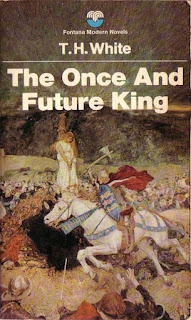Today’s letter is O and today’s post is about a favourite book of mine, The Once And Future King by T.H White. This may be one of the first books I bought with my own money, at the local newsagent. It’s the story of King Arthur.
There have been plenty of books about Arthur over the years. Some of them are even favourites of mine, such as Rosemary Sutcliffe’s Sword At Sunset, Mary Stewart’s Merlin series that began with The Crystal Cave and ended with The Wicked Day, which was about Medraut, Arthur’s illegitimate and incestuously begotten son. (That Medraut was a nice lad, determined not to betray his father as the prophecy predicts, but he just can’t overcome the prediction). Another favourite is Parke Godwin’s Firelord, which presents Arthur as a Romano-British soldier and has touches of fantasy. There’s even Bernard Cornwell’s Warlord Chronicles which delighted me by presenting Lancelot as a pompous, vain man who looks a lot better than he is - I never did like Lancelot. Marion Zimmer Bradley’s The Mists Of Avalon was seen from the viewpoints of the women of Arthur’s story.
 |
| This is the edition I have |
But The Once And Future King, a collection of White’s four Arthurian novels, is special - and it’s used a lot, often by people who haven’t heard of it. For example, just as people use the Laws of Robotics without ever having heard that they were created by Isaac Asimov, they take it for granted that Merlin living backwards is a part of the original story of Merlin instead of something created by this author. I’ve read it so many times - for example, in Arthur, King by Dennis Lee Anderson, in which it’s a vital part of the plot, and Peter David’s Knight Life, in which Merlin escapes from his cave in the modern era because he is now in the body of a child.
The musical Camelot was based on The Once And Future King, with its lovable Arthur, and the romance between Guinevere and Lancelot being sung in songs such as “If Ever I would Leave You” and “I Loved You Once In Silence”. And The Once And Future King is based on Thomas Malory’s fifteenth century work “Morte D’Arthure”, with its fifteenth century knights and ladies and castles in a distant past. In its turn, that is based on some French romances, as Shakespeare’s plays were based on various sources. Malory didn’t invent the story, but his is the version we think of immediately when we think of Camelot and Arthur. The young Malory even makes a cameo appearance in White’s novel and the musical based on it, as a page, Tom of Warwick.
Another dramatised version of T.H White is Disney’s The Sword In The Stone, based on the first novel of the four gathered under the covers of The Once And Future King. It’s the children’s novel of the four. In it, we learn that the young Arthur, called the Wart as a nickname, was taught by Merlin, by being turned into animals and birds. As a bird, for example, he learns that there are no borders. We also learn that the reason Merlin always knew what was going to happen is because he remembers it - this is where the idea of Merlin living backwards comes from.
The whole business of the anger of the Orkney brothers, Gawain, Gareth, Agravaine and Gaheris is shown as resulting not only from their love of their mother Morgause but from the rivalry between Gael and Gall. They first appear as young boys at home in Orkney and then head for Camelot, with the whole Gaelic world farewelling them.
This Arthur is pretty much Malory’s, but also White’s. Malory’s Arthur is a great king, but he isn’t there for social justice or sending out his knights with the slogan,”Not might is right, but might for right!” T.H White’s Arthur is. He cares, really cares, about his people - and his friends and family.
It’s quirky as well as moving. Sir Pellinore and his Questing Beast are a funny and sweet part of the story - and he is, after all, the father of the Grail Knight Percival, whose brother calls him Percy and explains his encounters with magical beasts by saying that Percy was fond of animals - a much nicer, gentler version of the character than in all those mediaeval Grail Quest stories.
I can’t help feeling that the knight and Questing Beast who appear in an episode of Lost In Space are inspired by this novel’s version of Pellinore.
If you can only read one Arthurian novel in the near future, read this one!
This is available in ebook and audiobook, plus paperback, from all the usual web sites.
5 comments:
Why do you think the story, in its various incarnations, stood the test of time? It still appeals to novelists, artists, film makers, costume designers and even historians.
Absolutely! It’s a story that has so much meat on it.
Once and Future King was one of the great books of my childhood, and I still love it. I also love Gerald Morris' Squire's Tales series, he saw the characters very similarly as I did.
The Multicolored Diary
I’ve heard of the Morris series, but not read them. Time to look them up!
Hi Stuart! I haven’t had the chance to get a copy of the Steinbeck book, but I’d like to. He didn’t finish it, I believe, as he died before he could, but he really cared for the story and went to England, to Somerset, to immerse himself in it. When you think about the fact that his regular stuff was set in California, about his own time, he must have felt it was a special story to throw over everything to write it.
Post a Comment